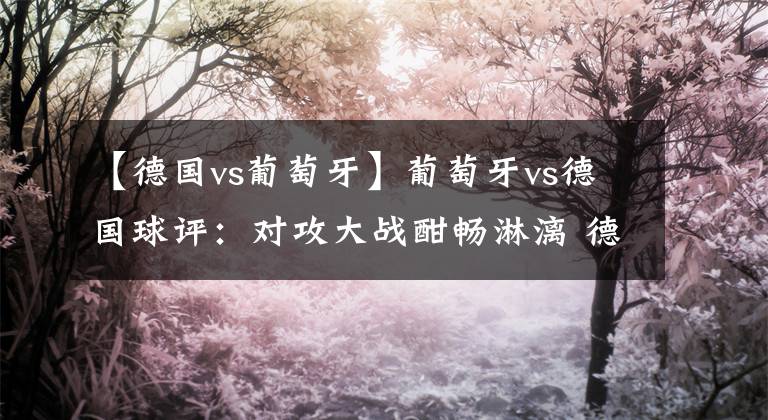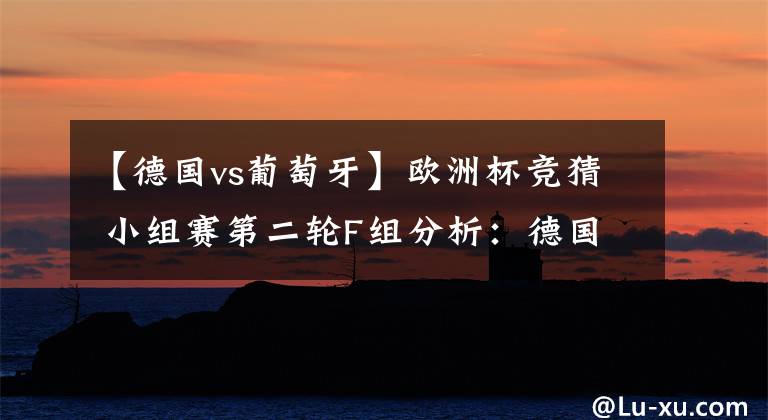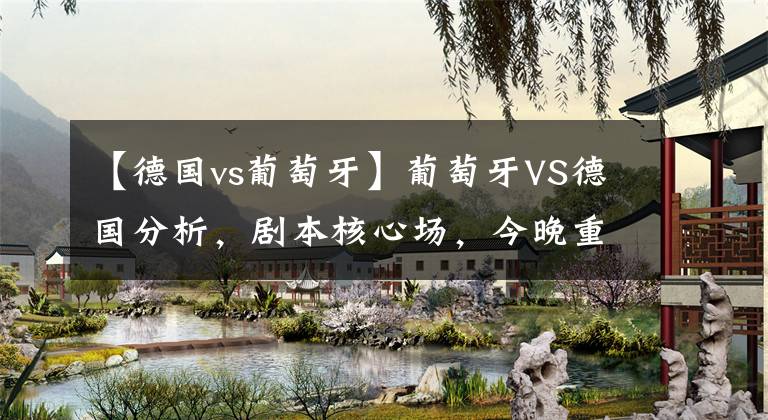欧元2020: gosens cooks Portugal ' s goosePortugal vs Germanytactical analysis
[足球双语战术分析] 2020欧洲杯:葡萄牙对德国-战术分析
June 21、2021 David Seymour
On Friday,Portugal played Germany in a group f euro 2020 fixture . it was Germany who came out on top,Bouncing back from their previous loss toit was an interesting game,Where the momentum switched between either side as the game progressed . Germany had an early goal disallowed,DuePortugal weren ' t able to recover and swiftly found themselves down 4-1 in to,before a consolation goal from diogo jota rounded up the score
周五,葡萄牙在2020欧洲杯F组小组赛中与德国相遇。
本场比赛,德国从此前输给法国的比赛中恢复了过来,以4-2的比分击败了葡萄牙,最终取得胜利。这是一场十分精彩的比赛,比赛走势随着时间的推移而不断改变。由于拜仁慕尼黑球员托马斯·穆勒手球犯规在先,德国在开场后不久的一粒进球被取消;而凭借着克里斯蒂亚诺·罗纳尔多的进球,葡萄牙率先取得领先。不过,由于拉斐尔·格雷罗和鲁本·迪亚斯先后打入乌龙球,德国在半场结束前又夺回了领先优势。葡萄牙没能及时对丢球做出回应,并很快在下半场落入了1-4落后的局面。随后,迪奥戈·若塔挽回颜面的进球再次扩大了当天的总进球数。This tactical analysis gives an in-depth analysis of the tactics used by both sides in this fixture.
这篇战术分析将深度解析双方本场比赛的战术。
Line-ups and formations
首发阵容与阵型
Portugal fielded a 4-1-4-1 formation, with no personnel changes from their 3-0 win over Hungary. The only difference was with Danilo Pereira being employed as a single pivot in this game, whereas against Hungary he was joined as a double pivot by William Carvalho.
葡萄牙排出了一套4-1-4-1的阵型,与他们上一场3-0战胜匈牙利的比赛相比并未做出任何人员调整。唯一的不同之处在于达尼洛·佩雷拉出任了单后腰,而在上一场比赛中则是由威廉·卡瓦略与前者搭档双后腰。
Similarly, Germany fielded the same line-up as in their 1-0 loss to the French. Most notably, Joshua Kimmich continued in the right-wing back position, as did Serge Gnabry in the centre-forward role. Muller, and Chelsea‘s Kai Havertz played behind him, in slightly more narrow roles than they did in the French game, the impact of which will be explained later on in this analysis.
同样,德国也排出了与他们上一场0-1负于法国相同的首发名单。最值得注意的是约书亚·基米希继续担任右翼卫,塞尔吉·格纳布里也同样继续位于中锋位置。穆勒与效力于切尔西的凯·哈弗茨则在格纳布里身后,他俩的位置与上一场相比略微内收,这一点所带来的影响将在后文解释。
Portugal’s use of quick breaks
葡萄牙对快攻的利用
Portugal conceded possession to Germany, taking just a 41.72% share of possession on the day. It was clear from the word go that they intended to hurt the Germans on transition. This won’t be the only time Germany are targeted in this way in this tournament. With a midfield duo of Ilkay Gundogan and Toni Kroos, whilst outstanding ball players, neither are particularly known for their defensive work. With Gosens and Kimmich playing as wing-backs there will be space to hit in behind on the counter against that back three of Antonio Rudiger, Mats Hummels and Mathias Ginter. When you look at the players in this German starting XI, it makes sense to look to hurt them on the break with direct attacking play.
葡萄牙将本场比赛的控球权让给了德国,当天,他们的控球率只有41.72%。显然,比赛伊始,葡萄牙就试图在攻守转换中对德国造成威胁。这并不是德国在本届杯赛中第一次被如此针对了,他们拥有着伊尔卡伊·京多安和托尼·克罗斯组成的中场双人组,尽管两人均为出色的控球大师,但他们都不以防守见长。而戈森斯和基米希出任边翼卫则意味着在反击时,他们的身后将会有可以直接攻击由安东尼奥·吕迪格、马茨·胡梅尔斯和马蒂亚斯·金特尔组成的后场三人组的空间。当你观察德国首发十一人时,你会发现利用直截了当的进攻方式来冲击他们是有很意义的。
Portugal managed just seven shots in total over the course of the game, and yet three of these came from counter-attacks. With an overall 1.96xG for the game, we can see that just over half of this value came from their counter-attacks. These came overwhelmingly through the centre of the pitch, with Cristiano Ronaldo the focal point of the attacks.
全场比赛,葡萄牙只完成了7脚射门,但其中的3脚都来自反击机会。可以看到在葡萄牙全部的1.96个期望进球数中,超过一半的数值都来源于他们的反击。这些机会全部来自中路进攻,C罗是这些进攻尝试的焦点。
Their first goal came from such an event, with Ronaldo surging forward in the central channel. His presence was enough to draw the attention of Germany’s center-backs towards his run, as we can see in the image below, and Diogo Jota was able to steal into the space behind and receive the pass over the top.
他们的第一粒进球正是在这样的机会中诞生的,C罗在中路向前冲刺,他的出现足以吸引德国中卫们的注意,迪奥戈·若塔因此得以溜入中卫身后的空间接过顶球。
Diogo Jota was then able to roll the ball across goal for Ronaldo to punch home.
随后,迪奥戈·若塔横传C罗,后者将球打进。
When Portugal were able to break immediately from Rui Patricio they were very effective but understandably less so when Germany’s defense were behind the ball and in shape. Even when Portugal turned the ball over in midfield they still looked to play forward quickly. There was a lack of compactness in attack though, particularly when Ronaldo dropped in as we can see below.
当葡萄牙的进攻能够迅速从鲁伊·帕特里西奥处发起时,它们会非常高效;而可以理解的是,当德国的防线仍然齐整地位于皮球之后时,这样的进攻就不再奏效了。甚至当葡萄牙还在中场传递时,他们就想着快速向前推进了。他们的进攻缺乏紧凑性,尤其是当C罗回撤时,如下图。
Ronaldo would look to get on the ball in deeper areas, and would find space as he sought to do so. However, as he offloaded possession, there were no runs in behind from his supporting cast.
C罗想在更深的区域得球,并且会在他想要持球时找到接应空间。然而,当他将球传出时,他的队友们却并没有跑动。
Below is a perfect example as William Carvalho received the pass from Ronaldo and surged forward. We can see that he was instantly surrounded by four German defenders. There is a lack of any kind of runs being made in behind, with Portugal struggling to have players push forward into attacking areas in these instances. We can also see how deep Ronaldo remained, not impacting the counter.下图是一个很好的例子。威廉·卡瓦略接到C罗的传球后向前带球,前者瞬间就陷入了4名德国球员的包围圈。他身后的队友缺乏任何形式的跑动,在这种情况下葡萄牙的球员们很难向前推进来到进攻区域。我们同样可以看到此刻C罗的位置有多么靠后,在这个位置并不能对反击带来影响。
The Germans looked to exploit the attacking width provided by the wing-backs by narrowing Portugal’s 4-5-1 out of possession as much as possible. They used quick interplay between their midfielders and all three of Gnabry, Havertz and Muller were given the licence to drop in and help overload in central areas.
德国人希望利用边翼卫提供的进攻宽度尽可能地压缩葡萄牙4-5-1阵型的控球权。他们利用中场球员的快速传切配合以做到这一点,前场三人格纳布里、哈弗茨和穆勒都可以回撤来减轻中场的压力。
We can see the effect this had on Portugal’s shape in the image below, whilst the high and wide positioning of Robin Gosens on the left flank should be noted.
在下图中,我们可以看到这种打法对葡萄牙整体阵型的影响,而戈森斯在左翼前插幅度之深、拉扯幅度之宽都应当引起我们的注意。
Germany’s defenders would push forward to allow them to stretch the pitch too. Below we can see right-sided centre-back Ginter pushing forward to provide an outlet as Germany drew the Portuguese shape towards the left flank.
德国的后卫们同样会前提以帮助球队最大限度地利用球场空间。在下图中,当葡萄牙的整体阵型被牵扯至左路后,右中卫金特尔前提为球队增加出球点。
But what allowed Germany’s wing-backs to push even further forward was how aggressive the German centre-backs positioning was. When Hummels felt there was the possibility to step forward and help switch play himself, he would do so. This prompted Ginter to move out of that position and shift wide to where right wing-back Kimmich would have been. And then of course this would allow Kimmich to push further forward.
不过,德国的两名边翼卫能够深度前插的根本还是德国中卫们激进且富有侵略性的站位。当胡梅尔斯观察到有前插参与进攻梳理的机会时,他就会立刻前提站位。他的移动提示着金特尔来到右翼卫基米希原本的位置以拉开宽度,而金特尔的横移又可以让基米希进入到更深的区域参与进攻。
Throughout their possession phase, Germany looked to have their attacking players cover the entire width of the pitch. We can see how with both wing-backs pushed high in the image below, Portugal’s back four is outnumbered.
在德国控球时,他们希望能让他们的进攻球员拉开宽度覆盖整个球场。如下图,当德国的两名边翼卫都来到高位参与进攻时,葡萄牙的四名后卫便在人数上处于劣势。
Kroos would drop deep to get on the ball and would hit diagonal balls in behind on top of using combination play with those around him. We can see in the previous image how Portugal’s midfield five stay rigidly narrow, and whilst they are heavily protecting any central forward passes from Kroos, the only German player in this area is Gundogan. This left plenty of space in between the lines for Muller, Gnabry or Havertz to drop into, but it also meant that both Kimmich and Gosens were necessary attacking outlets for Germany to use to play behind.
克罗斯会深度回撤持球,并且利用身边球员的跑动送出过顶身后球。在上一张图中我们可以看出葡萄牙中场五人的站位有多么狭窄,并且他们都在尽力试图破坏克罗斯的任何中路向前传球,尽管在这一区域仅有京多安这一名德国球员。
By playing into the wing-backs, Germany could draw the Portuguese full-backs out of shape and have their central attacking players make runs in behind.
利用边翼卫的持球,德国可以将葡萄牙的边后卫拉扯出来,这样他们的中路进攻球员就得以冲击身后区域。
Or Kroos might look to instantly play in a wing-back behind. We can see Kimmich looking for this with an angled 45 degree run behind.
或者,克罗斯会立刻为边翼卫送给出身后球,可以看到基米希正在进行45°斜插以寻求这种配合。
The use of Gosens in attack
进攻中对戈森斯的使用
However, of the two German wing-backs, it was Gosens who was most effective. He was purposefully left very wide and high by Joachim Low, and as we can see from the pass map below, Germany looked to have their attacking trio play closer to the right side, and therefore more of their build-up came in areas further away from Gosens.
然而,在德国的两名边翼卫中,戈森斯才是最高效的那名球员。他被尤阿希姆·勒夫刻意地安排在左路高位上,在下面的传球线路图中可以看出,德国希望让他们的前场三人组更靠近右路,因此他们的进攻更多地在远离戈森斯的位置进行组织。
It was through this tactic that Germany were able to get their third and, to an extent, fourth goals of the game.
而德国正是利用这样的战术攻入了他们本场比赛第三粒进球的,甚至在某种程度上,第四粒进球亦是如此。
For the third, they focus their play away from the left flank and Portugal’s defence dropped into a compact shape. Gnabry’s run in behind towards the right side of the 18-yard-box created enough space for the pass out to Gosens, who was then able to have the time and space to play across goal for Havertz to score from.
在第三粒进球中,德国在远离左路的区域控球,葡萄牙的防线收缩得非常紧凑。格纳布里在禁区右侧的跑动为戈森斯创造了足够的接应空间,因此戈森斯有充足的时间和空间为哈弗茨送出最后一传。
Again for the fourth goal, Germany were able to pick out Gosens at the back post, and this was partly down to some abysmal marking from Rafa Silva, who allowed the wing-back to just glide into the box whilst the Portuguese refrained from getting goal side. This allowed Gosens to score on the hour mark, and put the game to bed with 30 minutes left to play.
而在第四粒进球中,德国在后点准确找到了戈森斯。这粒丢球一部分要归咎于拉法·席尔瓦糟糕的防守,他让这名翼卫轻松地溜进了禁区,而他自己却没能出现在靠近球门的一侧。这使得戈森斯在比赛第60分钟取得进球,提前30分钟杀死了比赛的悬念。
It wasn’t just through combination and narrowing the opponent where Germany were able to exploit the wing-backs.
德国能够完全发挥边翼卫的能力靠的不仅仅是团队配合与压缩对手空间。
With Muller and Havertz playing either side of Gnabry they naturally operated in the half-spaces, and were able to shift across to create overloads with their wing-backs against the Portugal full-backs. This overload could be accentuated by Gnabry dropping into the 10 space to receive a pass, and encouraging one of the Portugal centre-backs to step forward, as we can see below. This instantly created a 2v1 on one side.
由于穆勒和哈弗茨在格纳布里的两侧活动,因此他们可以很自然地在两翼展开控球,并且能够通过横移与边翼卫一起让葡萄牙的边后卫陷入一防多的局面。如下图,当格纳布里回撤至10号位接应并带走一名葡萄牙中后卫时,这种劣势会被再次放大,瞬间就创造出了2打1的机会。
Gnabry would look to bounce the ball back safely to a player who could then pick out the wing-back with a direct diagonal pass, and allow the inside forward to run in behind and exploit the overload.
格纳布里会迅速将球回传给能够能够直接斜长传找边翼卫的队友,随后内锋便可以利用2打1创造机会。
Conclusion
结语
The result of this game, along with France’s draw to Hungary, means the final games in Group F will be very interesting to watch. Portugal looked dominant in their 3-0 win over Hungary, but this result and performance was a far cry from that game, whilst it was the opposite for the Germans. They looked void of ideas against the French and yet have bounced back from that result to put four past one of the tournament favourites. It’s too early to have any true insight into the direction of Euro 2020, but this game, along with the France-Hungary game, has certainly delayed us being able to truly predict the strongest teams emerging from Group F.
本场比赛的结果以及法国与匈牙利的平局意味着F组的最后一轮比赛将会变得极具戏剧性。葡萄牙在他们3-0战胜匈牙利的比赛中占据统治地位,但是他们本场比赛的赛果与表现都与上一场相距甚远,而德国则截然相反。他们在对阵法国时破门乏术,不过他们已经找回了状态,第四次击败了本届欧洲杯的夺冠热门之一。现在要对2020欧洲杯的发展方向有任何真正的了解都为时过早,但是本轮的这两场比赛却明确地推迟了我们预测F组最强之师的时间。
Vocabulary:
came out on top 出类拔萃;最后取得成功
courtesy of 由于……;承蒙……的好意
consolation n.安慰;起安慰作用的人或事
whereas conj.然而;鉴于
concede v.承让;退让
whilst conj.然而;尽管
counter-attack n.反击
overwhelmingly adv.压倒性地;占绝对优势地
understandably adv.可理解地
compactness n.紧密
prompt v.提示;鼓励
abysmal adj.糟糕的
Source:
1.《【德国vs葡萄牙】【足球双语战术分析】2020欧洲杯:葡萄牙vs德国—战术分析》援引自互联网,旨在传递更多网络信息知识,仅代表作者本人观点,与本网站无关,侵删请联系页脚下方联系方式。
2.《【德国vs葡萄牙】【足球双语战术分析】2020欧洲杯:葡萄牙vs德国—战术分析》仅供读者参考,本网站未对该内容进行证实,对其原创性、真实性、完整性、及时性不作任何保证。
3.文章转载时请保留本站内容来源地址,https://www.lu-xu.com/tiyu/2729977.html







